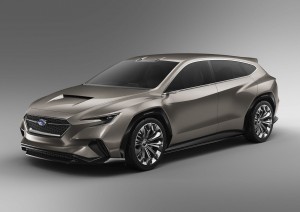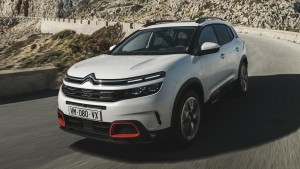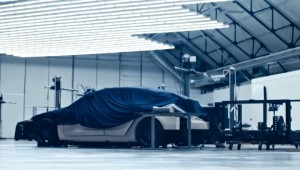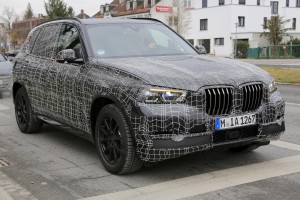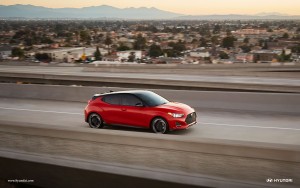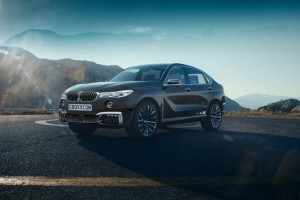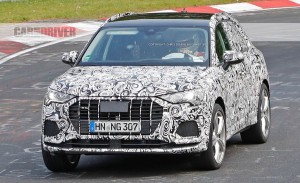Monthly Archives: May 2018
Jaguar Land Rover Is Developing An All-Terrain Self-Driving Tech
Jaguar Land Rover is now developing a self-driving technology that can handle any type of terrain and weather conditions. The system will be able to identify various surface conditions and adjust the vehicle’s settings without any intervention from the driver.
The company, which is known for its off-road SUVs, first announced this system two years ago. But last week, Jaguar Land Rover revealed that it partnered with various groups, including the University of Birmingham to form the group known as CORTEX.
For the system to work, various cameras, ultrasonic, radar and LiDAR units will be used. These sensors would tell the car about the conditions of the road it is driving on. They will scan the surroundings constantly, up to 16 feet ahead at the most. But the sensors won’t only detect road situations. It would also be able to determine weather conditions—dirt, rain, ice, snow, and fog.
The data will then be analyzed and artificial intelligence will predict the potential impacts and effects of the surrounding conditions on the vehicle. Thus, the vehicle will automatically adjust its speed, steering, and even suspension.
The sensors would also be able to measure the space above and on the sides of the vehicle, a feature that would be helpful in warning the vehicle if there is insufficient clearance to maneuver. This is the same technology used in parking assistance systems.
Another type of technology that Jaguar Land Rover is developing is a kind of “platoon” system, wherein a fleet or convoy of vehicles would be able to communicate in such a way that the first vehicle on the line would send a message if it encounters a ditch or a slippery boulder.
The company has yet to announce when this technology will become available. What Jaguar Land Rover is making clear is the fact that it does not intend to take away the fun in off-road driving. The driver can take control of the vehicle anytime he/she wants. This technology is merely an aid that could guide the driver on the conditions ahead.
The Citroen C5 Aircross SUV Is Built For Comfort
The Citroen C5 Aircross SUV was first unveiled at the Shanghai auto show last year for the Chinese market. The thing is, the European market will get one as well and it will be fitted with what Citroen is calling the “progressive hydraulic cushions.”
This means that the Aircross will come with a pair of hydraulic stops on either side of the regular shock, spring, and mechanical stop setup. This will help with the compression and decompression, providing a comfort never before experienced in SUVs trying to be sportier rather than comfortable for its passengers.
You see, that’s the problem with many SUVs in the market these days. The segment has forgotten that it should provide comfort for its passengers rather than make itself look sporty and ready for the race track. Owning an SUV is more than just about going off-track. It’s about comfortable city driving.
The patented suspension setup will mean there’s “zero bouncing” from “major impacts” on the road, Citroen said. For additional comfort, you can also opt for the advanced comfort upholstery. This means 155mm-thick foam and loads of reinforcement. There’s also an 8-inch central tablet with voice recognition controls, connectivity buttons, wireless smartphone charging, and a connected camera.
There’s safety tech, too, aside from the level of comfort this SUV provides. The C5 Aircross will come with safety braking, departure warning, lane-keeping, adaptive cruise control, collision and coffee alerts, driver attention alerts and even traffic sign recognition.
As for the drivetrain, the C5 Aircross will have two petrols available: a 128bhp and a 177 bhp 1.6-liter four-pot. There are three diesel choices: two 128bhp and one 177bhp. There are reports that there will also be a plug-in hybrid drivetrain, but there’s no word yet on when that will be. Apparently, it will be able to run 37 miles in pure EV mode and would feature disruptive CO2 emissions.
3 Things We Know About The 2020 Chevrolet Suburban
We finally caught a glimpse of the first prototype for the redesigned Chevrolet Suburban, which will likely come out as a 2020 model.
The spy shots revealed a few clues about how the new Suburban will look like, especially based on the T1XX body-on-frame platform that Chevrolet used on the recently revealed 2019 Chevrolet Silverado 1500 and GMC Sierra 1500.
1. New Platform
General Motors is currently in the process of redesigning its full-sized fleet using the T1XX platform that suits both SUVs and pickups. This platform is an evolution coming from the K2XX platform. This new one will use aluminum rather than steel to shed some pounds off the new Suburban. The 2020 SUV will likely be 300-pounds lighter, according to reports.
2. Design Borrowed From Silverado
There’s a lot of camouflage on the prototype, but it looks like the face and the headlight especially will be based on the latest Silverado. Though the engineers tried to hide the vehicle’s rear axle, we can see that there’s an independent rear suspension rather than the solid rear used on the current generation Silverado. The new Ford Expedition is likely the culprit to this change.
3. More Powertrains
There will be a wider range of powertrains for the new Suburban. It is very likely that we will see General Motors’ new 2.7-liter turbocharged inline-4 with cylinder deactivation fitted. This powertrain can produce 310 horsepower and 348 pound-feet of torque. This has been confirmed for the new Silverado.
There’s another powertrain: a 5.3-liter V-8 engine with advanced Dynamic Fuel Management cylinder deactivation technology. The top-of-the-line is a 6.2-liter V-8 machine that churns out a whopping 420 horsepower and 460 pound-feet of torque. This engine is currently in the Suburban RST trim.
The new Suburban will likely arrive in late 2018 or early next year, and will be followed by a redesigned version of the smaller Tahoe.
Tesla Model Y To Be Revealed On March 15
There are some pretty outrageous things that have been said on Elon Musk’s Twitter account, and another crazy claim from the Tesla CEO is that the Model Y will be revealed on March 15. Yes, as in 10 months from this date.
When Musk said that the reveal date is on March 15, Twitter handle @DMC_Ryan remarked that the date was “oddly specific” and that he cannot tell if the Tesla CEO is serious or not. Musk answered, “I just made that up, because the Ides of March sounded good” but followed it up with “But consider it real.” He added that Tesla could unveil the Model Y anytime from late 2018 to middle of next year, so March 15 sounds about right.
That’s a pretty big window for a schedule, considering that there is still a lot of drama surrounding the Model 3’s production. Tesla can’t even settle the production issues of the Model 3 and then, there’s the Tesla Semi. Throwing in the Model Y into the fray is a bit crazy, but nothing is crazier than Tesla, Musk, and their production and delivery dates all thrown together.
If the Model Y will debut on March 15, it will begin its production by mid-2020, barring other issues. Of course, we’re all assuming that the Model Y’s production will befall the same fates as the Model S, the Model X, and the Model 3, all of which suffered from delays in production and delivery.
There is no hate here. We’re just pointing out the obvious that Tesla has made some erroneous promises in the past and have not kept them. With Tesla’s past representative of what could happen, it certainly means we will encounter some trouble along the way. But since we’re pretty excited about this small electric SUV, we’re hoping Musk will finally make true his overzealous timeframe.
New BMW X5 To Feature The Latest iDrive Infotainment System
BMW has confirmed that a new model under its X series will become available by the end of this year. The BMW X5 will also be the best platform for the German brand to feature its latest iDrive infotainment system.
The new fourth-generation BMW X5 will be revealed most likely at the Paris Motor Show in September, and might become available in dealerships around the end of 2018. This information was confirmed by BMW head Harald Kruger during BMW’s 98th annual general meeting. This will be the fourth X model to arrive this year, after the X2, the new X3, and the X4.
This new SUV will be the first vehicle to feature BMW’s latest iDrive infotainment technology, which is called the BMW Operating System 7.0. The same system will also be featured in the upcoming 3 Series saloon and the flagship X7.
The spy shots revealed a lot about the evolutionary design language that BMW has used for the X5. As a rival to the Range Rover Sport and Porsche Cayenne, the photos showed the company’s latest hexagonal lighting signature even when it is completely covered in camouflage.
CLAR Platform
The current X5, which was introduced in 2013, is still using the same platform as the second-generation X5 from 2006. The biggest challenge then is finding a suitable platform for the new X5, and this could be the CLAR platform, which has already transitioned from the saloon to the SUV in the latest X3. On the latter, the platform has already shed off 55kg off the kerbweight. The larger X5 will have more saving in terms of weight and fuel efficiency.
The new X5 will follow the 5 Series’ four- and six-cylinder petrol and diesel engines.
SUV sales for BMW grew rapidly in the past decade as this segment continues to be the main focus of customers. The company hopes to build on that success when the X5 is revealed later this year.
Mercedes-Benz Plans To Build Electric Compact Car In France
Daimler is investing as much as $589 million in Hambach, France to produce a small electric car for Mercedes-Benz. This is the first move by the German automaker to jumpstart its plans of producing 10 electric vehicles by 2022 and finally competing with US rival Tesla and its Model 3.
The Smart brand is producing all of its EVs in Hambach. Markus Schaefer said in a statement that the Smart plant in Hambach will become a part of the brand’s global compact car production network. The lead plant will be placed in Rastatt, Germany.
Mercedes is working to make its vehicle underpinnings suitable for the conditions it wants—to be able to mass produce a variety of electric vehicles in the same volume as models with gasoline, diesel, and hybrid engines. Such a move will allow the German automaker to boost production once the orders start to come in.
Making 620,000 units of compact vehicles last year, Mercedes is currently producing its compact A-Class, B-Class, and GLA models in Rastatt, Germany, in Kecskemet, Hungary, in Beijing, China, and in Aguascalientes, Mexico. Its US rival, Tesla, was able to deliver 101,312 vehicles last year.
There was no information what EV Mercedes is planning to initially produce, though the brand presented the Concept EQA in September. It is an electric car with a 250-mile range and has the ability to recharged without having to be plugged in.
The French plant is being adapted to make it possible to house a variety of EVs that Mercedes will have in the pipeline. Particularly, the facility is being readied for the first-ever Mercedes-Benz passenger car in France. It looks like Daimler is expecting orders to pour in for its electric compact car as its Hambach plant, where Daimler produces its electric and combustion-engined two-seater Smart vehicles, can already produce more than 80,000 units in a year.
Three-Door 2019 Hyundai Veloster Starts At $19,385
It’s the only car right now with three doors—one door on the driver’s side and two doors on the other side. The weird and yet familiar design of the Hyundai Veloster skipped the 2018 model year, but would be back this 2019 with a few upgrades.
Base Veloster
The base Veloster will be coming with a naturally aspirated 2.0-liter inline-four that can produce 147 horsepower and 132 pound-feet of torque. Paired with a six-speed manual transmission and featuring a direct injection, it will be more powerful than the previous 1.6-liter four. Standard safety equipment are forward-collision warning with automated emergency braking, lane-keeping assist, and a driver-attention monitor.
Other tech goods include LED running lamps and a rear spoiler. Seventeen-inch alloy wheels, a 7.0-inch touchscreen, a six-speaker stereo, Apple CarPlay, Android Auto, a six-way manual driver’s seat, and a real metal key.
2.0 Premium
With the same engine but with six-speed automatic and paddle shifters, the 2.0 Premium has a price tag of $23,635. That price will also get you 18-inch wheels on 225-width tires, blind-spot warning with rear cross-traffic alert, a panoramic sunroof, automatic climate control, heated front seats with leatherette inserts, keyless entry with push-button start, an 8.0-inch touchscreen with SiriusXM satellite radio (which is no longer standard on base Velosters), an eight-speaker Infinity stereo, and wireless device charging. You can also enjoy three years of Blue Link telematics services.
Turbo R-Spec
For $23,785, the Veloster will come with a turbocharged 1.6-liter that produces 201 horsepower and 195 pound-feet of torque. The six-speed manual is standard and upgrades will include thicker front and rear anti-roll bars, Michelin Pilot Sport 4 summer tires, LED taillights, LED low-beams with automatic high-beams, a black grille, adjustable rather than fixed rear headrests, specific cloth trim, and Active Engine Sound. The Turbo R-spec will not carry the 2.0 Premium’s blind-spot warning, panoramic sunroof, automatic climate control, and heated front seats.
The Turbo R-spec, however, can get the 2.0 Premium’s features plus the side-mirror turn signals and seven-speed dual-clutch automatic for $2,500 more.
Turbo Ultimate
The loaded Turbo Ultimate will be sold $27,535 for the manual and $29,035 for the automatic. Standard equipment would be the rain-sensing wipers, pedestrian detection, leather with contrast stitching, a dashtop head-up display, navigation, and HD radio. The automatic version will come with adaptive cruise control and the manual will have the summer Michelins.
BMW X8 Flagship SUV Focuses On Rear-Seat Comfort
BMW X8 render. (Photo Source: BMWBlog)
New details about BMW’s flagship SUV, to be called the X8, are emerging. Reports suggested that the BMW X8 will focus on giving rear-seat passengers a comfortable experience.
By all appearances before, the X8 didn’t look like it would go the coupe-SUV route. What was understood before was that BMW would focus on maximizing the rear seats for the comfort of the passengers, especially the Chinese consumers which the X8 will be targeting.
But an Autocar report published on Friday said that the X8 will feature a sloping roofline and a more coupe-like design like the smaller X4 and X6. The BMW is planning to position the X8 flagship as a rival to the Range Rover and to the Bentley Bentayga and the Rolls-Royce Cullinan if the X8 will tick off every box on the options list.
Now, in addition to the rear passengers’ extra space, the X8 will still feature a sloping coupe-like roofline that for most cars won’t be able to accommodate the needed extra space in the rear side. The X8, however, will be employing modern architectural and engineering technology to make this possible even with a slanted roofline.
The platform to be used will prove to be difficult for the German automaker, though reports indicated that the engineers will likely take elements from BMW’s CLAR modular platform and the Rolls-Royce Cullinan’s aluminum architecture.
This means that the 2020 BMW X8 will only be a four- or five-seater to achieve a comfortable experience for rear passengers. The upcoming BMW X7, which the X7 iPerformance concept previewed, will boast three rows of seats for a total of seven seats.
BMW will trademark the X8 to numerous markets around the world, including in Asia and most particularly in China. A final decision on how the X8 will look like will be made later this year before the SUV is released in 2020.
3 Things To Expect From The 2020 Audi SQ3
The Audi SQ3 is the sporty and level-up version of Audi’s second-generation Q3 crossover, which will be unveiled in late July. The SQ3 will come with the trademark aggressive S styling treatment and four exhaust pipes.
This performance version of the Q3 will match the power output of the outgoing RS Q3, which will have a new iteration of Audi’s turbocharged 2.5-liter inline-five that produces at least 400 horsepower later on. The RS Q3 was not released to the American market, making the SQ3 much more in demand and anticipated.
1. Platform
Like the base model Q3, the Audi SQ3 will use the Volkswagen Group’s MQB modular-transverse platform that is being used by a wide range of vehicles—from the small VW Polo to the Atlas SUV. The SQ3 will be similar in size to the current model, but the suspension will be tuned aggressively for minimum roll and sporty handling characteristics.
2. Powertrain
The Audi SQ3 will have the same EA888 turbocharged 2.0-liter four engine that can now be found in the Audi S3 and the Volkswagen Golf R. It can produce around 300 horsepower and can go from complete stop to 60 mph in just 4.5 seconds. It will have a top speed of 155 mph. The engine will come standard with a seven-speed dual-clutch automatic and Quattro all-wheel drive. We don’t have information on other powertrains available for higher-end versions.
3. Estimated Arrival and Price
The Audi SQ3 is expected to arrive in the United States in 2019 as a 2020 model. There is no information yet about the prices, but it will have a starting price of $45,000. Other variants will go north of that range with the available options offered to the vehicle.
The 2020 Audi SQ3 is competing directly with the BMW X2 and the Mercedes-AMG GLA45.
Spy Shots
Here are some spy shots of the Audi SQ3 from CarAndDriver:

